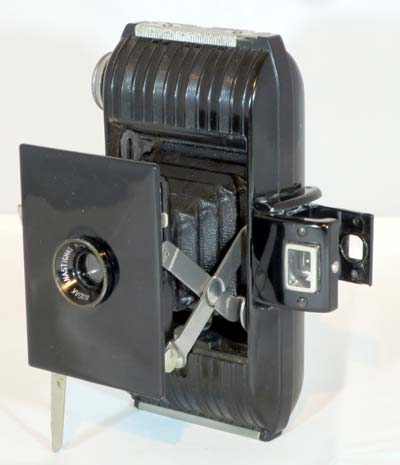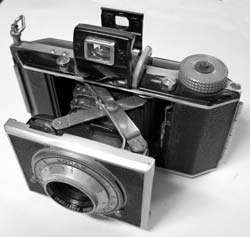Kodak Bantam 6.3
Specification

| Manufacturer | : | Kodak |
|---|---|---|
| Produced | : | 1938-1947 |
| Classification | : | Miniature |
| Body Type | : | Folding Strut- self erecting |
| Construction | : | Bakelite |
| Film Type | : | 828 |
| Film Width | : | 35mm |
| ImageSize | : | 4 x 2.8 cm |
| No. of Images | : | 8 |
| Lens Type | : | Kodak Anastigmat |
| Focus Type | : | Fixed |
| Focal Length | : | 53mm |
| Focal Range | : | 10ft - inf. |
| Aperture Type | : | Multihole |
| Aperture | : | f/6.3 and f/11 |
| Shutter Type | : | leaf |
| Shutter Speeds | : | T, I(1/40) sec |
| Size Closed (w x h x d) | : | 63 x 113 x 30 mm |
| Size Open (w x h x d) | : | 85 x 113 x 65 mm |
| Weight | : | 225g |
Art Deco Credentials
![]()
![]()
![]()
![]()
Significant: Pronounced and self evident
I consider this camera to warrant 4 stars for the following attributes:
- produced during the main Art Deco period
- designed by Walter Dorwin Teague
- Art Deco Streamline Moderne design
- Bakelite body with linear raised striped pattern
- shallow pyramid shape to lens plate
- rectilinear design on end of body
- chrome struts and highlights
- horizontal lines and curved body enhancing the streamline effect.
Description
The Kodak Bantam was produced between 1935 and 1948 and came in a range of miniature rollfilm cameras which introduced the 828 rollfilm size.
Variations

- 1935-37 Kodak Anastigmat f/6.3; simple direct vision finder; plastic body and lens panel
- 1935-38 Doublet f/12.5; metal folding frame finder; plastic body and lens panel
- 1938-41 Kodak Anastigmat f/5.6; folding optical frame finder; plastic body and metal lens panel
- 1938-47 Kodak Anastigmat f/6.3; folding optical frame finder; plastic body and lens panel
- 1938-48 Kodak Anastigmat f/4.5; folding optical frame finder; metal lens panel and metal body with angled ends; lens coated from 1946
The Streamline Moderne design was by Walter Dorwin Teague, a noted industrial design pioneer going back to the 1930's. Teague was responsible for the design of the famous Sparton table radios, a revamp of the Texaco gas station and logo, TWA identity and early Polaroid cameras. The streamlining effect was achieved by rounding the corners and by having no extraneous decoration.
How to Use
The film for this camera is not easily available. The Bantam is NOT a 35mm camera. It was made for 828 film which is a paper backed film with only one registration hole per frame. The film gate size is slightly larger than 35mm but the overall width of the film is the same. However, you have a number of options:-
- Use old expired film.
- Find some 828 backing paper and roll 35mm film in it.
- Cut down 120 film to fit.
What I suggest is to have fun with some expired film, keep the backing paper and spools, and then load it with 35mm film.
Using Expired Film

Old expired film can easily be found on the internet. However, there is usually no way of knowing how the film has been stored and so the results are variable. The secret is to over-expose old film. The general rule is one stop per decade for colour film and one stop per two decades for B&W.
Use 35mm film with 828 backing paper
If you have some 828 backing paper, it is possible to roll some 35mm film into it. You will need about 42cm of 35mm film. This can be taken from a 35mm film canister. You should be able to get 3 rolls of film from one canister. The film gate is larger than that of a 35mm camera so the image covers the sprocket holes giving a very nice effect. To do this, please refer to Use 35mm film in an 828 camera
If you don't want to bother with an exposure meter, follow the guide shown. It is based on the 'Sunny 16' rule. Film is so forgiving and will produce acceptable results even when overexposed by 2 or 3 stops or underexposed by 1 stop.
Remember that the exposure guide in the camera user manual may not be helpful as it is based on the use of old film with a low ISO value.
The tables assume that the sun is at least 30 degrees above the horizon - that's 10am - 5pm on a summer's day in the UK.
If you are not sure about the light level, err on the side of overexposure - i.e. assume the smaller f number.
This camera has a choice of two aperture values - f/11 and f/6.3.
Where there is a choice, a larger f number will give a larger depth of field.
For the slower speeds, you may need a tripod to stop blur through shake.
Using ISO 100/125 unexpired film
Key: Green, Good exposure; Amber, acceptable exposure. Number of stops over or under shown.
| Weather Conditions | Shadow Detail | Shutter Speed (s) | ||
|---|---|---|---|---|
| 1/25 | 1/50 | 1/100 | ||
 Sunny SunnySnow/Sand | Dark with sharp edges | - | - | f/11 +2 over |
 Sunny Sunny | Distinct | - | f/11 +2 over | f/11 +1 over |
 Slight Overcast Slight Overcast | Soft around edges | f/11 +2 over | f/11 +1 over | f/11 |
 Overcast Overcast | Barely visible | f/11 +1 over | f/11 | f/6.3 +1 over |
 Heavy Overcast Heavy Overcast | None | f/11 | f/6.3 +1 over | f/6.3 |
 Open Shade Open Shade/Sunset | None | f/6.3 +1 over | f/6.3 | f/6.3 -1 under |